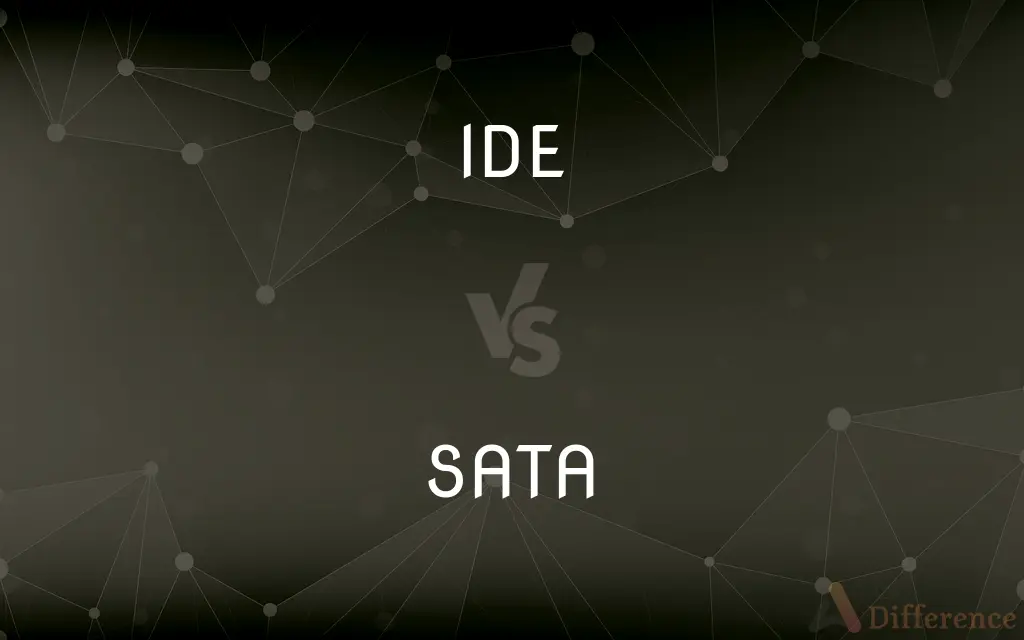IDE vs. SATA — What's the Difference?
By Tayyaba Rehman — Published on January 15, 2024
IDE is an older disk interface standard, while SATA is a newer one with faster data transfer rates.

Difference Between IDE and SATA
Table of Contents
ADVERTISEMENT
Key Differences
IDE, which stands for Integrated Drive Electronics, is an older standard for connecting storage devices like hard drives and optical drives to a computer's motherboard. SATA, short for Serial Advanced Technology Attachment, is a more recent interface standard designed for the same purpose. The primary difference between the two lies in their design and performance capabilities.
IDE has been around since the 1980s and became the dominant standard for many years. SATA, on the other hand, was introduced in the early 2000s and brought several improvements over IDE. One of the major differences between IDE and SATA is the way they transfer data. IDE utilizes parallel data transmission, while SATA uses serial data transmission.
Another distinction between IDE and SATA is the physical connector and cable design. IDE cables are wider and bulkier, often with 40 or 80 wires. SATA cables, however, are thinner with just 7 or 15 wires, making them more flexible and easier to manage within a computer case. This streamlined design is advantageous for airflow and cooling within a system.
Furthermore, SATA offers faster data transfer rates compared to IDE. The earliest SATA version provided a data rate of 1.5 Gbit/s, which was faster than the maximum IDE speed. Subsequent SATA versions further increased these rates. In contrast, IDE speeds peaked with the Ultra ATA/133 standard, which had a maximum data transfer rate of 133 MB/s.
In terms of power, SATA drives are more energy efficient than IDE drives. The SATA interface was designed to require less power, which can lead to energy savings and potentially longer device lifespans. This difference is particularly noticeable in laptop computers where battery life is crucial.
ADVERTISEMENT
Comparison Chart
Transmission Method
Parallel
Serial
Introduced In
1980s
Early 2000s
Cable Design
Wider with 40 or 80 wires
Thinner with 7 or 15 wires
Max Data Rate
133 MB/s (Ultra ATA/133)
Initially 1.5 Gbit/s, with later versions faster
Power Efficiency
Less energy efficient
More energy efficient
Compare with Definitions
IDE
Integrated Drive Electronics, a standard for connecting drives to computers.
My old computer still uses an IDE hard drive.
SATA
A standard known for faster data transfer rates compared to IDE.
SATA revolutionized data storage with its speed and efficiency.
IDE
The principle of consistently applying certain rules or standards.
The team adheres to a strict IDE in all their designs.
SATA
Known for its power efficiency in storage devices.
I prefer SATA drives in laptops for their power efficiency.
IDE
The representation or imitation of something.
The painting is an IDE of a famous photograph.
SATA
Serial Advanced Technology Attachment, a computer bus interface for connecting storage devices.
My new laptop has a SATA SSD, which is much faster than the old HDD.
IDE
A theory or system of social organization.
The new policy is based on a progressive IDE.
SATA
An interface with thinner cables improving airflow in systems.
One of the advantages of SATA is its slim cable design.
IDE
An abbreviation for Integrated Development Environment, software for coding.
I use an IDE to develop and test my software projects.
SATA
Modern connection standard succeeding the older IDE.
Many modern computers phased out IDE in favor of SATA.
IDE
A freshwater fish of the family Cyprinidae, found across northern Europe and Asia, especially Leuciscus idus.
IDE
Same as first Id, the fish.
Common Curiosities
What is the main difference in data transmission between IDE and SATA?
IDE uses parallel data transmission, while SATA uses serial data transmission.
Is IDE older than SATA?
Yes, IDE has been around since the 1980s, while SATA was introduced in the early 2000s.
Which has faster data transfer rates, IDE or SATA?
SATA offers faster data transfer rates compared to IDE.
What does IDE stand for?
Integrated Drive Electronics.
How do the cables of IDE and SATA differ?
IDE cables are wider and bulkier, while SATA cables are thinner and more flexible.
Are SATA drives more power efficient than IDE drives?
Yes, SATA drives generally require less power than IDE drives.
What is SATA an abbreviation for?
Serial Advanced Technology Attachment.
Can I connect an IDE drive to a SATA port?
Directly, no. However, there are adapters available that allow this connection.
Are there different versions of SATA?
Yes, there are multiple versions of SATA, with each new version generally offering faster data transfer rates.
Is IDE still in use today?
While largely phased out, IDE can still be found in some older systems and devices.
Which is more commonly used in modern computers, IDE or SATA?
SATA is more commonly used in modern computers.
Which is better for modern applications, IDE or SATA?
SATA is generally preferred for modern applications due to its advantages in speed, design, and efficiency.
Can both IDE and SATA be used in the same computer?
Yes, if the motherboard supports both interfaces, they can coexist in the same system.
Is the physical connector for IDE and SATA the same?
No, they have different connectors and are not directly interchangeable.
Why did SATA replace IDE in many systems?
SATA offers several advantages over IDE, including faster data transfer rates, better power efficiency, and a more modern design.
Share Your Discovery

Previous Comparison
Maskable Interrupts vs. Non-Maskable Interrupts
Next Comparison
Acetic Acid vs. AcetateAuthor Spotlight
Written by
Tayyaba RehmanTayyaba Rehman is a distinguished writer, currently serving as a primary contributor to askdifference.com. As a researcher in semantics and etymology, Tayyaba's passion for the complexity of languages and their distinctions has found a perfect home on the platform. Tayyaba delves into the intricacies of language, distinguishing between commonly confused words and phrases, thereby providing clarity for readers worldwide.
















































